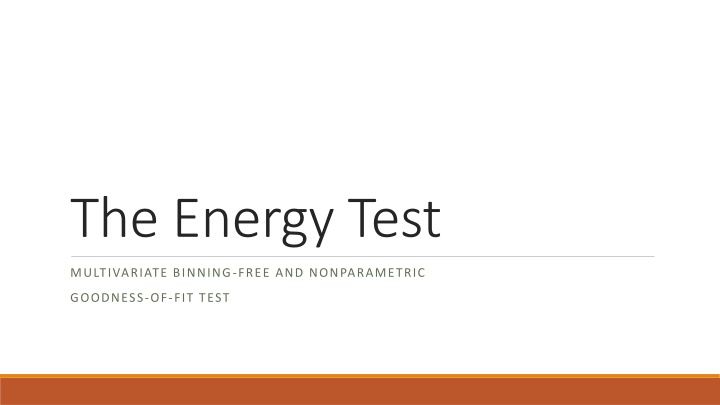
Energy Test: Nonparametric Multivariate Goodness-of-Fit Test
Learn about the Energy Test, a binning-free and nonparametric goodness-of-fit test used to evaluate statistical models against empirical data without the need for pre-prepared tables. Discover how it can be beneficial in various scenarios, such as at CERN's LHCb to detect CP-violation in particle decays. Explore the significance level, test statistics, and adjustments that can be made for accurate evaluations.
Download Presentation

Please find below an Image/Link to download the presentation.
The content on the website is provided AS IS for your information and personal use only. It may not be sold, licensed, or shared on other websites without obtaining consent from the author. If you encounter any issues during the download, it is possible that the publisher has removed the file from their server.
You are allowed to download the files provided on this website for personal or commercial use, subject to the condition that they are used lawfully. All files are the property of their respective owners.
The content on the website is provided AS IS for your information and personal use only. It may not be sold, licensed, or shared on other websites without obtaining consent from the author.
E N D
Presentation Transcript
The Energy Test MULTIVARIATE BINNING-FREE AND NONPARAMETRIC GOODNESS-OF-FIT TEST
Goodness of fit tests Such a test of a given model describes how well it fits a set of observations. Usually, we are interested in the confirmation or negation of the chosen probability distribution function (p.d.f.). We can use them to check whether : our statistical model agree with empirical data two samples are drawn from identical distributions given sample follow the specified distribution There exist a big varariety of the most popular are: Kolmogorov Smirnov (require estimation of parameters) Chi squared (require arbitrary binning)
Why Energy Test can be better? 1. It is nonparametric, so there is no need to use pre-prepared tables. 2. It is binning free (binning always is arbitrary). 3. It is multivariate and scales well with further dimensions. Chi-square test for a triangular random number generator ??- number of drawn numbers in j-th interval N number of randomly generated values ??- the theoretical probability of drawing a number in the j-th interval
Test statistic 1 2 1 ???+1 1 1 ?, ???? ? ? ?(? 1) ? ? ?( ? 1) ? ? ? ? ? ? ? = ??? 2 Terms are normalized ???weighting function
How can we adjust your test? First of all , we must choose metric e. g. Euclidean distance: ??? 2= ????,?(??,? ??,?)2 Now we can consider different weighting functions: ???= ??? ???= -?? ???+ ? ??? 2?2 1 2 ???= ?
Significance level Now we need to evaluate given T in order to confirm/deny null hypothesis. We do it by the p-value which is the probability of obtaining test results at least as extreme as the results actually observed, under the assumption that the null hypothesis is correct. P-value will be different for each entry data and to determine it we perform permutation test. We assign randomly data entries to each sample and perform Energy Test on a big number of such small chunks. Then we place T from full analyze and see where it belongs against other T-ies.
Usecase at CERN At LHCb Energy Test is used to find CP-violation. CP (charge conjugation parity symmetry) is a physics law that sometimes does not apply and this indicates a room to formulate new more precise theory than the Standard Model. However such cases are extremely rare and hidden in a big number of normal events. In the experiment, decays can be described by 2 dimensions in case of 2-body decay or 5 dimensions in 3-body decay that is why standard statistical tests are not the best option. We compare empirical measurements witch theoretical p.d.f and when we spot a p-value smaller than that associated with 5 we can tell that we observed CP-violation and can further investigate this specific data sample.
CUDA CUDA is a language extension that allows making computations on GPU instead of on CPU. Computations on GPU are massively parallel (thousands of threads concurrently). If calculations can be efficiently divided into independent subparts there is a possibility to gains significant performance bust. Moving data is costly in comparison to making calculations so GPU can outperform CPU only on large enough datasets. GPU scale better than CPU with the growth of data input size.
Energy Test with CUDA acceleration Number of permutations CPU [s] GPU[s] 1000 0.511 1.040 10000 0.921 1.030 100000 5.038 2.700 900000 45.319 17.7 One permutation 64 elements.
Thank for listening! Questions? Bibliografia: arXiv:hep-ex/0203010 Wiktor ychowicz
